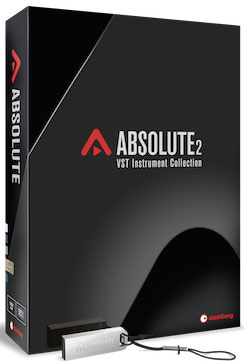 Steinberg – you know, the folks who invented VST (virtual studio technology) in 1996 – just released Absolute 2, a huge collections of VST virtual instruments. If you would like a primer on what you can do with VST plugins in your home recording studio, see our article, VST Plugins – Add Effects and Virtual Instruments to Your Home Studio.
Steinberg – you know, the folks who invented VST (virtual studio technology) in 1996 – just released Absolute 2, a huge collections of VST virtual instruments. If you would like a primer on what you can do with VST plugins in your home recording studio, see our article, VST Plugins – Add Effects and Virtual Instruments to Your Home Studio.
To find out more details about Absolute 2, read the article from MusicTech.net here: http://www.musictech.net/2015/09/steinberg-absolute-2/
New Noise Reduction Tool In Audacity
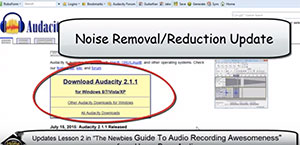 Audacity ( is a free audio recording and editing software program that can do some amazing things for the price:). We even have a tutorial course with videos showing you how to begin audio recording with almost no budget by using audacity – The Newbies Guide To Audio Recording Awesomeness 1: the Basics With Audacity.
Audacity ( is a free audio recording and editing software program that can do some amazing things for the price:). We even have a tutorial course with videos showing you how to begin audio recording with almost no budget by using audacity – The Newbies Guide To Audio Recording Awesomeness 1: the Basics With Audacity.
It has always had a noise reduction tool – called “Noise Removal” – that worked fairly well. But frankly, though it was OK in a pinch, it wasn’t really very good.
But with the release of version 2.1 in July, 2015, they upgraded the tool – now called “Noise Reduction.” And it works a lot better than the original version!
Below is a video demo of the new Noise Reduction tool in Audacity 2.1 (and later). I just did a quick voice recording with the air conditioning running in the room, which causes a steady, low frequency background noise. Judge for yourself:). You can hear the noise (and then lack of it) better if you wear headphones.
If you use Reaper, here is how to do noise reduction using their built-in tools: ReaFIR Madness – The Hidden Noise Reduction Tool in Reaper
Be Careful Not To Slice Up All Your Tracks In Reaper
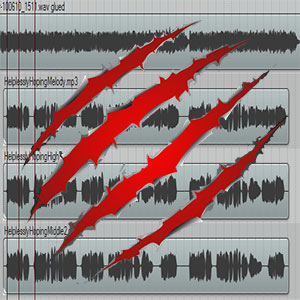 Reaper (http://reaper.fm) is an incredible recording program that I use just about every day. But like any piece of software, it only does what you tell it to do. And over the years, I have made many mistakes that I hope I can keep you from making.
Reaper (http://reaper.fm) is an incredible recording program that I use just about every day. But like any piece of software, it only does what you tell it to do. And over the years, I have made many mistakes that I hope I can keep you from making.
One of those mistakes was accidentally slicing up the audio on all my tracks when I only meant to apply slices to the audio in one track.
What Is A Slice?
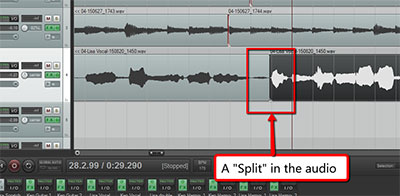
What I actually refer to is called a “Split.” If you have an audio file in a track, it is super easy to split it (into as many pieces as you need) wherever you want, just by placing your cursor and using the keyboard shortcut “S” ( And it’s non-destructive too. If you end up deleting one of the new pieces of audio, all you have to do is drag the edge of the audio item where you split it, and drag it back out to its original length. See Figure 1 to see what a split is.
To create the split in the picture, I clicked on the middle track, on the audio item, and put the cursor where I needed the split. But be careful!
If you use a lot of splits like I do (it’s handy for slicing up drum beats and moving them around), be very careful that before you hit that “S” key, you have selected/highlighted the audio on the track you’re working on! You need to actually click on the audio to do this, which I didn’t know at first. If you ONLY put the cursor where you want it, but no audio is selected (which can happen if you click where there is no audio – an empty part of a track, for example), you’ll end up creating a split at that point in time on every track with audio on it. See Figure 2 for what this would look like.
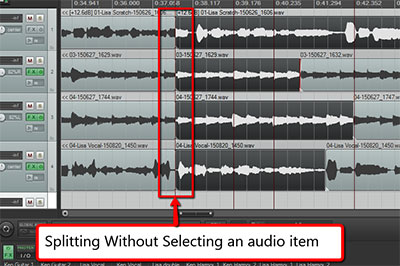
You can make matters even worse (like I did) if you don’t notice that you just put a slice across every track. Let’s say you have 4 tracks and you wanted to put 4 splits into, say, track 4. If you don’t select the audio in track 4 each time you execute the split, you will end up with a total of 16 slices instead of 4! Every track will have 4 splits.
You can end up with an awful mess on you hands if you don’t pay attention to this.
The ability to split an audio item is absolutely awesome. It is a fundamental tool in any audio project I do. You can move portions of audio forward or backward in time, fix timing mistakes music, edit dialogue/conversations, apply effects to one part of an item, etc. But with great power…..
So make sure you have the audio you want to split already selected (you’ll know because it will be highlighted) BEFORE you hit that “S” Key.
Adding An Effect To Just Part Of An Audio Track In Reaper
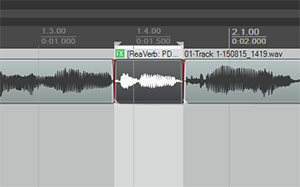 Have you ever been working on mixing audio tracks in a digital audio workstation (DAW) program (such as Reaper, Pro Tools, Sonar, Ableton Live, Logic Pro, etc.), and wanted to apply an effect to only one small section of a track? There don’t seem to be any obvious ways to do it, since effect plugins are almost always applied to the entire track. Well though it isn’t obvious, there is a quick and easy way to do it in Reaper. Here’s how.
Have you ever been working on mixing audio tracks in a digital audio workstation (DAW) program (such as Reaper, Pro Tools, Sonar, Ableton Live, Logic Pro, etc.), and wanted to apply an effect to only one small section of a track? There don’t seem to be any obvious ways to do it, since effect plugins are almost always applied to the entire track. Well though it isn’t obvious, there is a quick and easy way to do it in Reaper. Here’s how.
What’s In A Track?
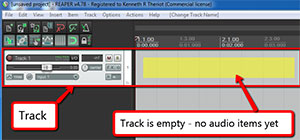
First it might be handy to review what a track actually is. Basically, it’s just a container that we see on the screen of a DAW, usually stretching horizontally across the screen. See Figure 1.
When you record (or insert) some audio, it goes into a track – you can see the “blobs” (the non-technical term for how audio wave forms are visualized:-P) in the track as you record them. When you stop recording, you have created an “audio item” in a track. See figure 2.
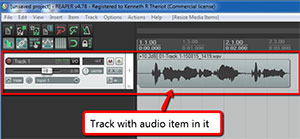
You can add more audio items into the same track, either by recording more audio or inserting a previously recorded audio file. You can also slice up a single audio item. There are several reasons someone might want to do this, but let’s say you have recorded a voice onto a track and want to apply an effect – say, reverb, for example – to JUST one word or phrase of that audio.
Usually, when you want to add an effect in Reaper, you click the “FX button on the track control panel (the area on the left of the track with all the buttons and knobs), and select your plugin. The assumption is that you’d want to apply that effect to the entire track. But that doesn’t help us here, does it? We only want that one phrase to have the reverb on it (this could be any effect though, like EQ or compression, etc.).
Split That Audio
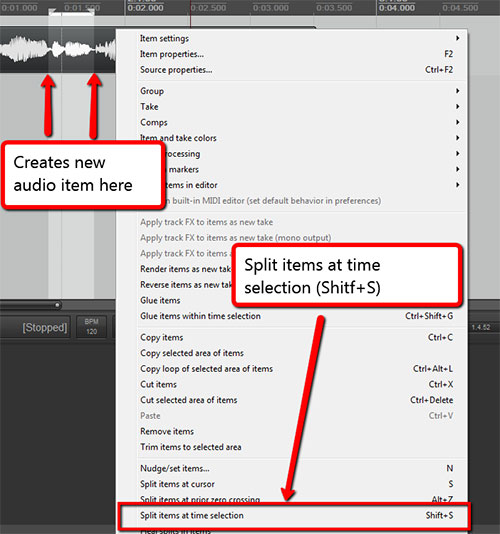
Reaper allows you to apply effects ONLY to an audio item in a track, even if you don’t have an effect selected in the track control panel. So in our example, you’d need to make your phrase its own item by “splitting” it. To do this, highlight the phrase and then right-mouse click anywhere on the audio item. This displays a drop-down menu of all sorts of things you can do to your audio item. We are looking for “Split items at time selection.” See Figure 3.
The keyboard shortcut for this action is “Shift+S.” It places a split at the edges of your selection. So be sure those edges start just before your phrase and end just after it.
Put Effect Only On Your New Item
So now that you’ve created a new audio item for the phrase you want to put reverb on, right mouse-click on your phrase to launch that drop-down menu again. This time, choose “Item Properties,” which brings up the Media Item Properties box. See Figure 4.
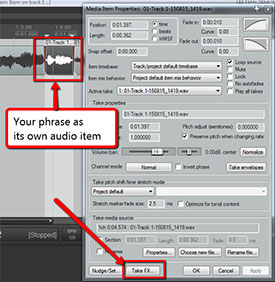
You want the button at the bottom that says “Take FX.” The term “take” is another word for “item” – as in “take 1, take 2,” etc. Anyway, clicking that button allows you to choose a plugin the same way as the “FX” button on the track control panel. But it will only apply that plugin effect to your item – exactly what we wanted. Cool, huh?
It takes a lot longer to explain that to actually do. It’s really easy and can be very useful for a number of things. Maybe you want to use EQ or compression to fix some audio problem in only a couple of places on a track. You can also use this technique to turn the volume down quickly on just a piece of audio by dragging the top of the item down.
So if you were wondering how you could apply an effect to just one small part of a track without affecting the rest of the audio on that track, now you know how to do that in Reaper.
Half-Off Sale On The Newbies Guide to Audio Recording Awesomeness
 Get The Newbies Guide to Audio Recording Awesomeness for 50% off the normal price this weekend – July 4th and 5th!
Get The Newbies Guide to Audio Recording Awesomeness for 50% off the normal price this weekend – July 4th and 5th!
Yup. Learn to record professional audio at home with our awesome (it says so right on the label:)) video tutorials. We keep it short, easy to understand, and entertaining.
CLICK HERE and find out all about the course. Take a quick tour of both modules and get 4 free videos. If you decide you NEED this course, the entire thing – which normally costs $67 – will run you only (yeah, yeah, I know you can divide by 2:-P) $33.50. That’s a lot of awesome for a really great price. Well, we think so, anyway.
But you can kick the tires for yourself here: The Newbies Guide To Audio Recording Awesomeness.
Whether you buy or not – Happy 4th of July Weekend! And for our many readers not living in the states – Happy weekend!